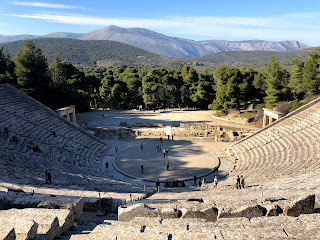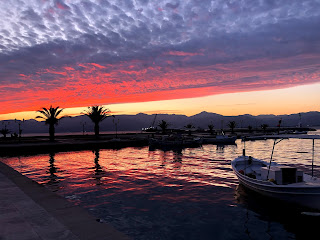My last week in Greece can be summed up in one word: chaotic.
As COVID-19 spread around the world, we watched as study abroad programs in Europe got shut down one by one. In Greece, we were relatively safe. Confirmed cases in early March had not yet hit 100 and only 9 cases had been reported in the city of Athens —relatively low compared to other countries. But we seemed poised on the precipice of being sent home, narrowly scraping by on many weekend trips. The virus hit Northern Italy and the city of Venice was shut down and quarantined a mere 7 days after our optional CYA trip to Venice and Ravenna. My roommate and I visited Madrid one week before an outbreak happened in Madrid. One-by-one, my friends’ programs were moved online, and everyone flew home. Some students in CYA had already left and every extra day I spent in Greece felt like a potential last day.
The night of Monday, March 9th, we received an email informing us that Greece had forbidden school trips for two weeks in an effort to slow the coronavirus. Our Northern Greece field trip scheduled for the following week had been postponed. We were heartbroken, it was a trip that everyone was looking forward to and the chances of it being successfully rescheduled seemed slim. However, other than that, everything felt normal. That afternoon, before my marble carving workshop, I took a nap. I woke up bleary eyed and confused to worried voices in the kitchen and hundreds of texts from my friends.
I walked out of my room and was immediately brought up to speed. American news sources had reported that the Greek government was shutting down all schools for two weeks and several universities had required students in our program return home. I checked my phone and saw that my home institution had also decided to evacuate students and switch to online learning. No one knew what was CYA was going to decide though. Our source was a one paragraph article from the Washington Post and the New York Times. We couldn’t read Greek sources and didn’t know which ones were reliable. We spent the next two hours pacing anxiously around our apartment waiting for some sort of news or update from CYA or our home institutions. Not having thought critically about the situation and the severity of it if Greece didn’t take immediate restrictive measures, our initial reaction was: “This is crazy! It’s not even that bad in Greece!”. We were angry, anxious, and confused.
I headed to my marble carving class in an attempt to hammer out some anxiety. An hour later, someone shouted “they sent an email”! Everyone scrambled to check their phones and read the email CYA had sent out. We were informed that the Greek government decided to order schools closed for 14 days, starting the next day, as a proactive measure to limit the spread. We would be operating online for the next two weeks and would need to send one person per apartment to school to pick up our lunches. The expectation was that school would continue normally after the two weeks.
Wednesday felt odd. It was supposed to be the middle of midterms week. Instead, we wandered the streets of Athens, visiting sites we hadn’t gotten a chance to see yet. A sense of foreboding loomed over us.
Wednesday night, only 24 hours after we were told that school was closed for 2 weeks, we learned that multiple home institutions had either given students the option to, or requested they return back to the U.S. A significant portion of our number were leaving by the end of the week. We decided to celebrate our limited time together and was then blindsided by another piece of information.
At around 3 a.m. on Thursday in Greece, President Trump announced the implementation of a travel ban on 26 European nations that would go into effect on Friday at midnight. All hell broke loose. Parents started calling students, schools sent out emails to students studying abroad…everyone was confused about who these restrictions applied to. Surely, they couldn’t ban U.S. citizens from returning home? One of my roommates and I sat in my room in shock. Neither of us had contacted our parents yet and our home institutions had yet to reach out. We sat there until almost 5a.m. wondering how everything changed so quickly.
I was woken up at 10a.m. by the sound of a zipper. Stumbling out of my room confused, I walked into the adjoining room to see one of my roommates packing. Her parents had called her at 6a.m. and booked her a flight home for 6p.m. that day. I sat in her room shell-shocked as she continued packing. She was leaving, today? Were other people also leaving? I texted my other friends to figure out what their plans were. I found out that some people had already left; packed up their things as soon as they heard and went to the airport. Some people were leaving that day and others the next. Most people’s parents or home institutions had required that they return home. If they weren’t leaving in the next two days, they would be in the week to come.
CYA informed us that they would continue through with the original plan. I waited anxiously for an email from Tufts. Were they going to tell us to go home? Were they going to let us stay? I called my dad in a panic asking him what I should do. It seemed like everyone was going home. Should I too? But CYA was staying open. I wanted so desperately to stay, but it felt like I would be the only one left.
I was in a panic. I refreshed my school email every 5 minutes waiting for the email they had promised to send out. I was also waiting for both my parents to be awake so that we could form a plan. The three of us were in three different time zones so there were only a couple hours each day when all three of us were awake.
In the meantime, my roommates and I watched our fourth roommate pack. We walked to Πικάντικο (Pikantiko) for her last gyros and hiked up the Areopagus for one last view of the Acropolis. When we saw Jane off in her taxi, the apartment felt a lot quieter. In an attempt to do something, my roommate and I decided to keep ourselves occupied. We wandered the streets of Plaka, bought souvenirs (because who knew what was going to happen!), climbed up to Filapappou Hill to watch the sun set, and joined our friends for one last taverna meal before they left the next morning. Everyone left in CYA then met up at Boy Scout Square for one last drink together. Everything seemed extra special. For some, it was “the last” and for others, like me, it was “what if it’s our last”.
Within the span of 48 hours, we had gone from taking our midterms, to a cancelled field trip, to cancelled school for two weeks, to everyone leaving. The number of people who were planning to stay in Greece had dropped from around 150 people to less than 30.
… To be continued










































